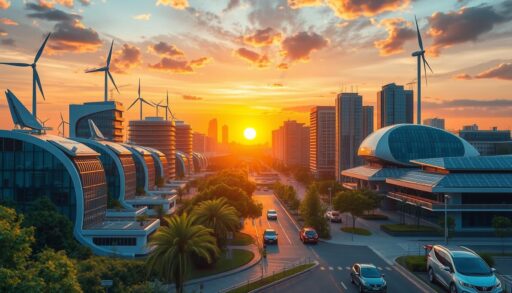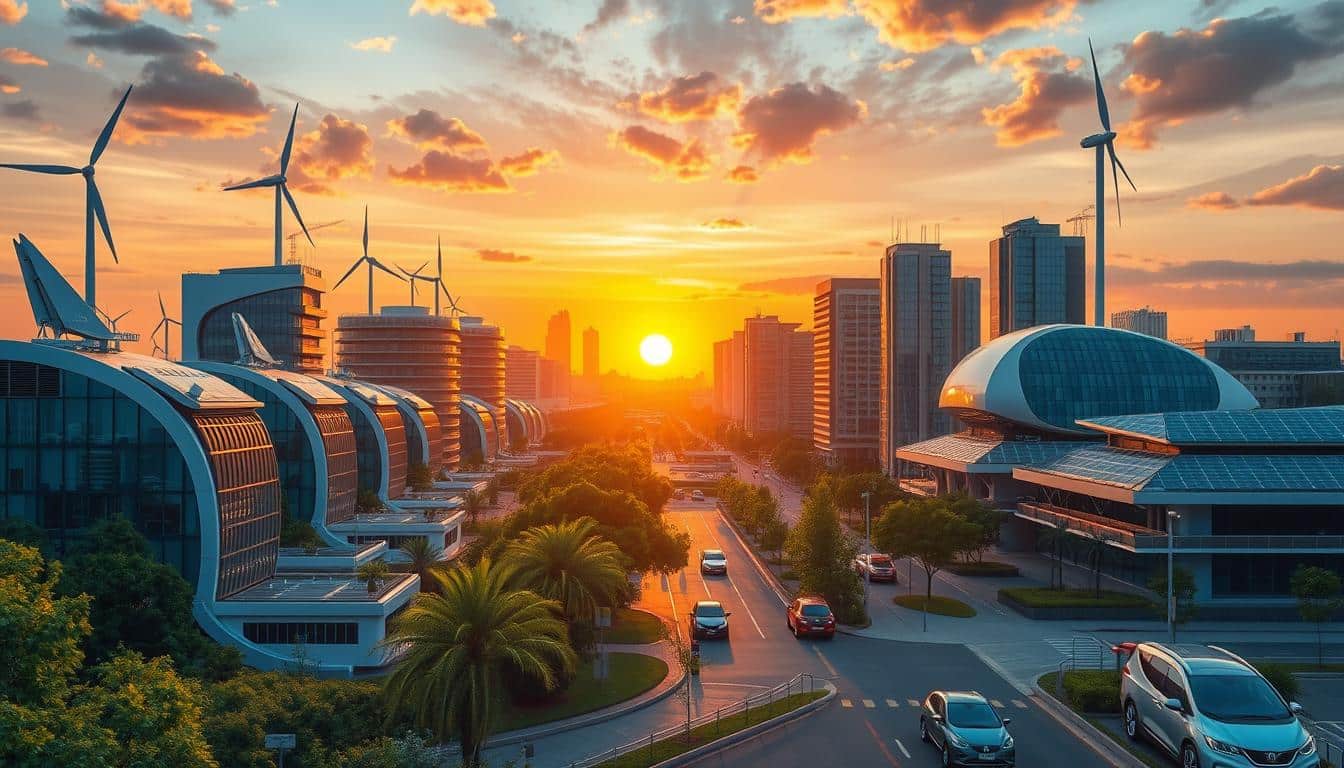The energy scene in the United States is changing fast. This change is thanks to clean energy and the need to fight climate change. Policymakers, leaders, and people around the world must understand these changes in energy policy.
This article looks at the big trends, challenges, and new ideas in the energy world. We’ll see how government policies, new tech, and smart grids are shaping our energy future. It’s all about making our energy use better and cleaner.
Key Takeaways
- The energy landscape in the United States is undergoing a transformative shift, driven by the growing momentum behind clean energy technologies and the need to address climate change.
- This article explores the evolving landscape of energy policy, examining the role of government policies, technological innovations, and the emergence of smart grid technologies.
- The article aims to provide a comprehensive understanding of the critical factors influencing the future of energy policy in the United States.
- The energy transition is far from on track, requiring radical action to change its trajectory, with the coming eight years being critical for accelerating the renewables-based transition to achieve the 2050 climate target.
- Politically-driven actions and well-targeted investments are essential to reach the 2030 milestone and transition to a clean energy economy, requiring concerted international cooperation.
The Shift Towards Clean Energy Technologies
The world is moving towards clean energy fast. This is because of the quick growth of renewable energy and the coming peak in fossil fuel demand. The IEA’s WEO-2023 report says solar, wind, and other renewables will make up 80% of new power by 2030. This means fossil fuels will drop from 80% to 73% of energy use by 2030.
Renewable Energy Sources Gaining Momentum
The shift to renewable energy is happening fast. In 2022, over 10 million electric cars were sold, a huge jump in five years. Renewable energy capacity grew to 340 GW, making up 30% of global power. Clean energy investment hit a record $1.6 trillion, up 15% from last year.
- Solar PV made almost 1,300 TWh in 2022, a 26% jump from the year before. It saw the biggest growth in renewable energy.
- Global solar PV manufacturing capacity will double in five years, meeting 2030 demand.
- In 2022, almost 95% of electric car sales were in China, the U.S., and Europe.
Peaks in Global Demand for Fossil Fuels
The demand for fossil fuels is expected to peak soon. The IEA says global CO2 emissions from energy will peak by 2025. This is a key step in fighting climate change. Moving to clean energy is crucial to keep global warming under 1.5°C by 2100, as the IPCC warns.
“The world is at a critical juncture in the global energy transition, with renewable energy sources poised to play a pivotal role in shaping the future of our energy landscape.”
Role of Government Policies and Technological Innovations
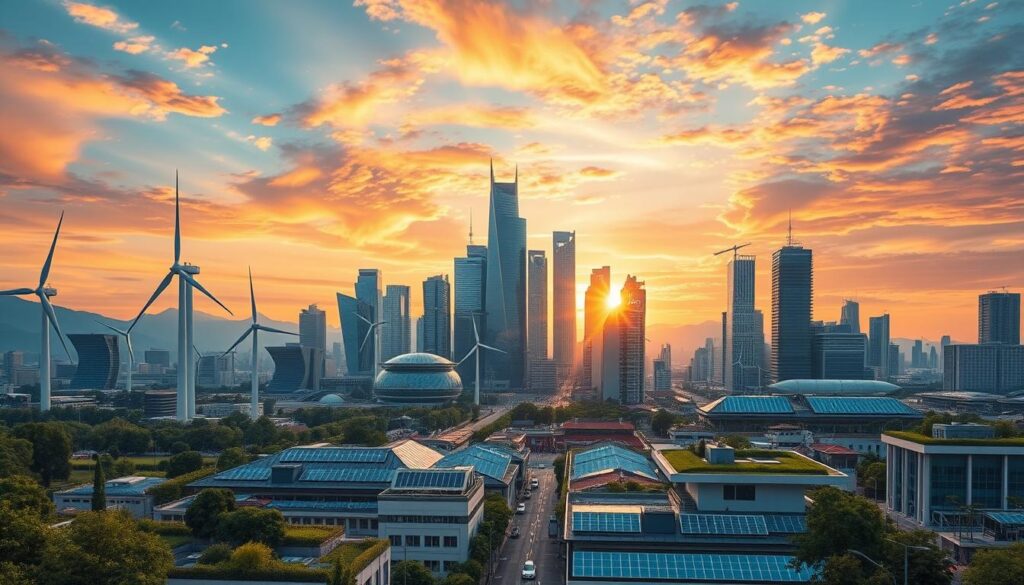
Government policies and new technologies are key to the clean energy shift. Laws like the US Infrastructure Investment and Jobs Act and the Inflation Reduction Act of 2022 offer big funding. This helps with modernizing the grid, growing renewable energy, and creating cleaner tech.
New tech, especially in digital and communication fields, is crucial for the smart grid. It makes managing and sharing electricity more efficient. It also works well with the ups and downs of renewable energy.
Money for research and development (R&D) helps companies deal with the high costs and long times of innovation. Tax breaks and other support can also boost startups working on clean energy.
- Government funding for R&D can spur scientific research and the development of new technologies.
- Entrepreneurship support, such as funding and training programs, can foster innovation culture.
- Intellectual property protection can provide legal safeguards for innovators, enabling them to profit from their work.
- Digital infrastructure investment in 5G, IoT, and AI can lay the foundation for smart energy systems.
- Regulatory support, through streamlined processes and regulatory sandboxes, can enable the deployment of new technologies.
- Collaboration between public, corporate, and academic sectors can drive multistakeholder innovation.
- International cooperation on standards-setting and global research projects can accelerate technological development.
| Policy Lever | Impact on Energy Innovation |
|---|---|
| Government Funding for R&D | Supports scientific research and technology development |
| Entrepreneurship Support | Fosters a culture of innovation and startup growth |
| Intellectual Property Protection | Provides legal safeguards for innovators |
| Digital Infrastructure Investment | Lays the foundation for smart energy systems |
| Regulatory Support | Enables the deployment of new technologies |
| Multistakeholder Collaboration | Drives innovation through public-private-academic partnerships |
| International Cooperation | Accelerates technological development through global coordination |
By using a mix of policies and new tech, governments can help the clean energy shift. This drives innovation and makes sustainable energy more common.
Energy Policy: Adapting to a Changing Landscape
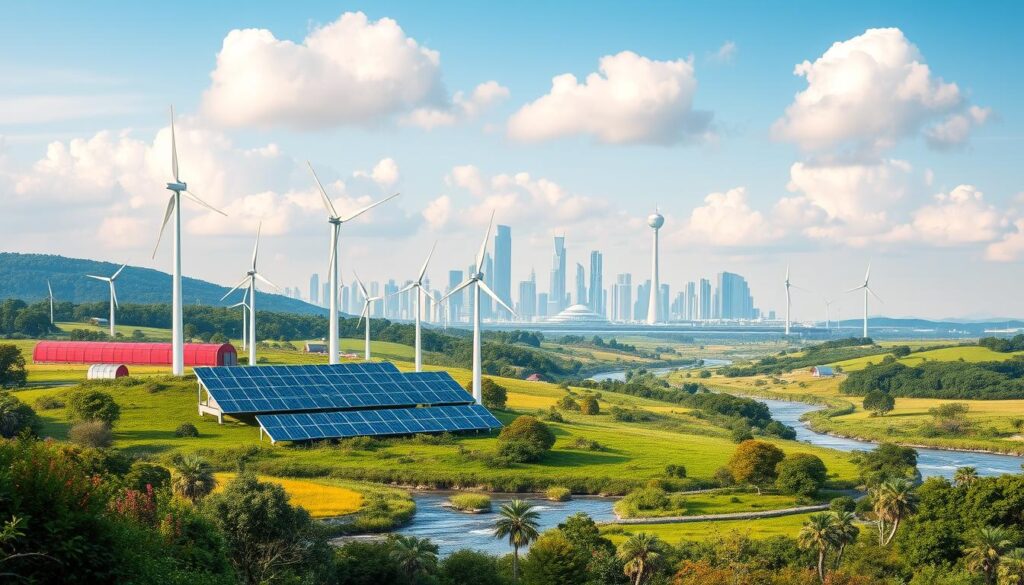
The energy world is always changing, and so must our policies. The WEO-2023 report suggests a global plan to get us on track by 2030. It has five key areas to help us move towards a greener, more efficient energy future.
The Five Pillars for Getting on Track by 2030
- Tripling global renewable capacity
- Doubling the rate of energy efficiency improvements
- Slashing methane emissions from fossil fuel operations by 75%
- Implementing innovative, large-scale financing mechanisms to triple clean energy investments in emerging and developing economies
- Measures to ensure an orderly decline in the use of fossil fuels, including an end to new approvals of unabated coal-fired power plants
These pillars highlight the need for renewable energy, energy efficiency, and fighting climate change. They aim to tackle major energy policy issues. This will help us move towards a cleaner, greener energy market.
| Pillar | Description | Expected Impact |
|---|---|---|
| Renewable Capacity Tripling | Significantly increasing the global deployment of renewable energy sources like solar, wind, and hydropower | Reduced reliance on fossil fuels, lower greenhouse gas emissions, and greater energy security |
| Doubling Energy Efficiency | Accelerating the rate of improvements in energy efficiency across various sectors, including buildings, transportation, and industry | Lower energy consumption, reduced strain on energy resources, and decreased energy costs |
| Methane Emission Reduction | Implementing measures to cut methane emissions from fossil fuel operations by 75% | Significant reduction in short-term climate impacts, complementing efforts to phase down fossil fuels |
| Financing Clean Energy Investments | Developing innovative financing mechanisms to mobilize large-scale investments in clean energy projects in emerging and developing economies | Accelerated energy development and energy use in underserved regions, fostering global energy equity |
| Orderly Fossil Fuel Decline | Implementing policies to ensure a managed and gradual phase-out of unabated fossil fuel use, including no new approvals for coal-fired power plants | Paving the way for a just and sustainable energy transition, minimizing disruptions and supporting energy security |
These five pillars offer a balanced approach to energy policy. They help tackle the complex challenges of the global energy landscape. They guide us towards a more sustainable and resilient energy future.
“Navigating the energy transition will require a comprehensive policy framework that aligns economic, environmental, and social considerations. The five pillars proposed in the WEO-2023 report offer a roadmap for policymakers to chart a course towards a more sustainable energy future.”
Smart Grids: Enabling a More Efficient Energy Future
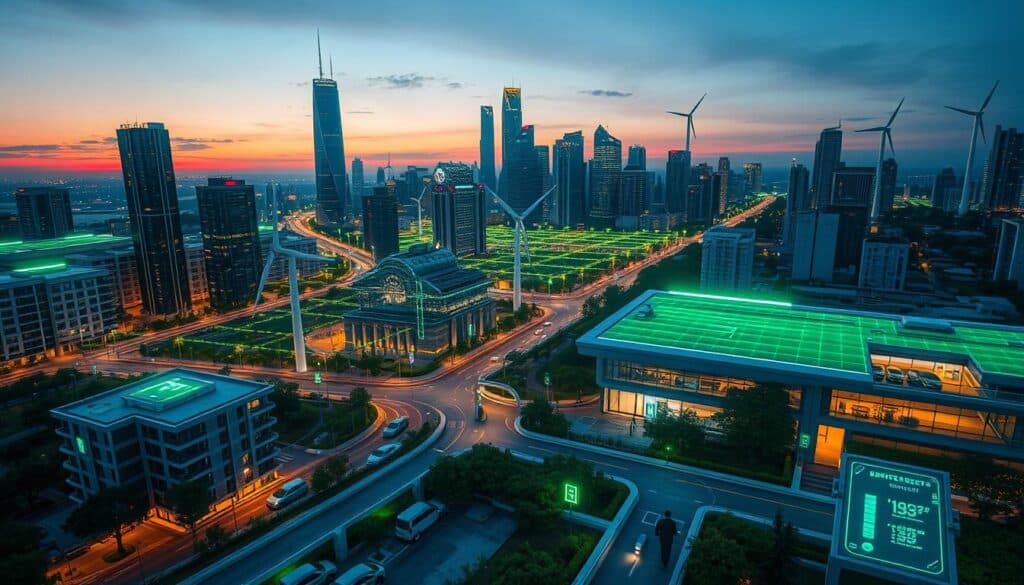
The shift to “smart grids” is a big step forward in how we manage electricity. It makes energy use more efficient, reliable, and green. Smart grids use advanced tech like sensors and smart meters for better communication between utilities and users.
This tech lets us watch and control energy use in real time. It makes electricity distribution better and more reliable.
Core Technologies: AI, Machine Learning, and 5G
AI, machine learning, and 5G are key for smart grids. They help use energy wisely, predict needs, and boost efficiency. Smart grid analytics and machine learning find patterns, predict needs, and spot problems, making things better.
IoT devices give us live info on energy use and grid health. This info helps smart grids work even better.
Using AI, IoT, and digital solutions makes energy management smarter and greener. Smart grids use these tools to balance energy supply and demand. They also make energy markets better, improve reliability, and cut costs.
| Technology | Role in Smart Grids |
|---|---|
| Artificial Intelligence (AI) | Predictive analytics, demand forecasting, anomaly detection, and optimizing energy distribution |
| Machine Learning | Predicting equipment failures, improving energy efficiency, and enhancing demand response strategies |
| 5G | Enabling reliable, high-speed data communication for real-time grid monitoring and control |
Smart grid tech is a big step towards a greener, more efficient energy future. It opens up new ways to do business, makes grids more reliable, and helps us use clean energy.
“Smart grids play a crucial role in facilitating the integration of high shares of variable renewables into the grid and supporting decentralized power production.”
Challenges in Smart Grid Implementation
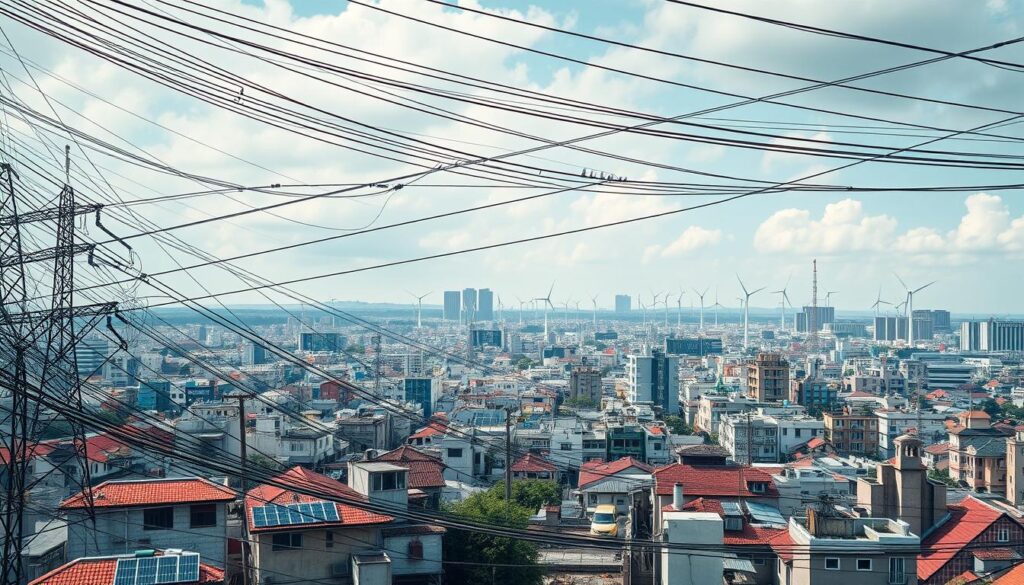
Smart grids bring big benefits like better energy use and being green. But, they face many challenges. These include technical issues and security worries. To work well, smart grids need to mix different energy types, like solar and fossil fuels.
They also need to automate substations and use the latest tech for sensing and measuring. This makes the grid smarter and more efficient.
But, smart grids are at risk from cyber attacks and data privacy problems. They need strong security to keep hackers out. Also, they must follow rules and handle data ethically to work right.
Technical Hurdles
- Streamlining the integration of multiple energy sources and grid automation processes
- Enhancing weather prediction capabilities for effective load balancing and grid stability
- Advancing sensor and measurement technologies to optimize energy production and distribution
Security Concerns
- Protecting smart grid networks from cyber threats, such as hacking and data breaches
- Ensuring data privacy and ethical handling of consumer energy usage information
- Aligning regulatory frameworks to address the evolving challenges of smart grid security
| Key Statistic | Insight |
|---|---|
| Global investments in smart grid technology must increase twofold through 2030 to achieve the goal of a zero-emission world by 2050. | Significant investment is required to overcome technical and security challenges and scale up smart grid implementation globally. |
| 2021 funding for smart grid technology from developing countries and emerging markets remained at 2020 levels, creating a considerable funding gap. | Bridging the funding gap, especially in developing regions, is crucial for widespread smart grid adoption and addressing energy access challenges. |
| Researchers have developed a fuzzy logic trust model to identify malicious nodes in smart grid networks, reducing the packet-dropping rate by 90%. | Innovative security solutions can enhance the resilience of smart grid networks and mitigate the impact of cyber threats. |
“The successful implementation of smart grids hinges on overcoming both technical complexities and robust cybersecurity measures to ensure the reliability and resilience of our energy systems.”
Also Read : What Is A Global MBA In Sustainability And Why Is It Important?
Conclusion
The evolution of energy policy in the United States is complex and dynamic. It’s shaped by the growth of clean energy technologies, the need to tackle climate change, and the impact of government policies and technological innovations. As the energy landscape changes, using smart grid technologies, integrating renewable energy sources, and setting up smart energy policies are key. These steps will help us move towards a more efficient, sustainable, and strong energy system.
By tackling the challenges and seizing the opportunities in this changing energy landscape, we can all work towards a cleaner and safer energy future. The data and insights in this article show the big steps forward in energy efficiency, energy productivity, and cutting industrial carbon intensity. Yet, we still face issues like energy burdens and the need for more energy codes adoption.
As the United States moves through the complex and changing energy policy world, we must use the progress in renewable energy, energy storage, and smart grid technologies. This will help us succeed in the energy transition and ensure a sustainable, fair, and strong energy future for everyone.
FAQs
Q: What is the significance of energy conservation in the context of national energy policies?
A: Energy conservation plays a crucial role in national energy policies as it helps to reduce energy consumption, lower costs, and minimize environmental impact. By implementing energy efficiency standards and promoting the use of renewable energy technologies, countries can enhance energy independence and decrease reliance on fossil fuels.
Q: How does nuclear energy fit into the future energy plans of the United States?
A: Nuclear energy is considered a key component of the future energy plans of the United States as it provides a stable and low-carbon source of energy. It helps to meet energy demand while supporting environmental protection goals. However, the policy implications of nuclear energy, including safety and waste management, must be carefully considered.
Q: What role does wind energy play in reducing energy consumption and increasing energy efficiency?
A: Wind energy contributes significantly to reducing energy consumption by providing a clean and renewable source of energy. It helps to increase energy efficiency by displacing fossil fuel use and lowering energy intensity in the energy sector. Investments in wind energy projects are essential for achieving energy independence and sustainability.
Q: How can solar energy contribute to energy self-sufficiency and energy independence?
A: Solar energy can greatly enhance energy self-sufficiency and independence by allowing households and businesses to generate their own electricity. This reduces reliance on imported energy sources and helps to stabilize energy prices. The expansion of solar and wind energy is vital for future energy security.
Q: What are the impacts of energy subsidies on renewable energy production?
A: Energy subsidies can significantly influence renewable energy production by making it more economically viable. By providing financial support through policies related to energy, governments can encourage the development of renewable energy projects, thus facilitating the transition towards a more sustainable energy future.
Q: How do energy efficiency standards affect energy demand in the residential sector?
A: Energy efficiency standards are designed to reduce energy demand in the residential sector by promoting energy-efficient appliances and building practices. These standards help to lower energy costs for consumers while contributing to broader climate and energy goals.
Q: What challenges does the energy sector face in achieving climate and energy goals?
A: The energy sector faces several challenges in achieving climate and energy goals, including the need to balance energy demand with environmental protection. Transitioning to renewable energy sources, overcoming energy trade barriers, and addressing energy poverty are critical challenges that require comprehensive energy policy decisions.
Q: How does the Federal Energy Regulatory Commission influence energy commercialization?
A: The Federal Energy Regulatory Commission (FERC) plays a vital role in energy commercialization by regulating interstate electricity sales, wholesale electric markets, and transmission of electricity. Its policies help ensure a competitive market, which can lead to improved energy efficiency and lower costs for consumers.
Q: What are the primary energy sources being prioritized in renewable energy projects?
A: The primary energy sources being prioritized in renewable energy projects include solar and wind energy, as they are abundant and have minimal environmental impact. These sources are integral to the transition towards energy sustainability and are supported by various federal and state policies.
Source Links
- https://www.iea.org/news/the-energy-world-is-set-to-change-significantly-by-2030-based-on-today-s-policy-settings-alone
- https://www.mckinsey.com/mgi/our-research/the-hard-stuff-navigating-the-physical-realities-of-the-energy-transition
- https://www.irena.org/Digital-Report/World-Energy-Transitions-Outlook-2022

